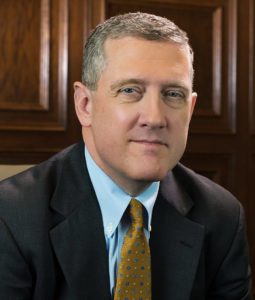
Federal Reserve Bank of St. Louis President and CEO James Bullard predicted the Federal Reserve Open Market Committee will raise interest rates to over 5 percent this year to ensure that inflation returns to its long-term 2 percent target.
Bullard discussed the Fed’s approach to taming inflation and outlined his economic predictions for the coming year on Jan. 12 during a virtual Midwest economic forecast forum hosted by the Wisconsin Bankers Association. The forum also included a 45-minute address from PNC Bank Chief Economist Gus Faucher.
Bullard’s comments came after the FOMC already raised interest rates seven times since last March, bringing the target range from near-zero to 4.25 to 4.5 percent. Last month, the FOMC announced it planned to raise their benchmark rate even higher to between 5 percent to 5.25 percent as inflation remained stubbornly high. Bullard said that the increase needs to come as quickly as possible so that the Fed can once again lower interest rates. Bullard, who said he supports the Fed’s front-loading approach to interest rate hikes, acknowledged that inflation has proven challenging to predict and could stay higher than 2 percent for longer than expected.
Bullard noted that fourth quarter U.S. GDP had above-trend growth at 3.2 percent following a period of negative GDP growth during the first half of last year. Households remain flush with deposits as they retain pandemic-era stimulus dollars. Bullard said brighter domestic sentiments are mirrored by improving economic conditions abroad. China’s recent decision to end mass lockdowns in response to Covid-19 is easing supply chain concerns. Economists are now more optimistic that Europe can avoid a recession.
PNC Bank Chief Economist Gus Faucher was more pessimistic about the economy. He predicted a mild recession this year with negative GDP growth of approximately 1 percent. Consumers are cutting back on residential investments, Faucher noted, and he expects the housing market will continue to drag after falling last year. Thirty-year fixed mortgage rates have doubled, from below 3 percent in the fall of 2021, to more than 6 percent. Existing home sales have fallen 30 percent from their peak and mortgage lending has faltered as well.
Faucher does also see positive economic indicators. Unemployment fell to 3.5 percent in December, and there are an estimated 1.7 job openings for every unemployed worker. Unemployment insurance claims remain low and quit rates are high as workers are confident that they can leave their current positions for better jobs. Credit quality remains strong, Faucher noted, as delinquency rates are low. Though the credit market is expected to weaken this year, Faucher expects that downturn will only be temporary.
